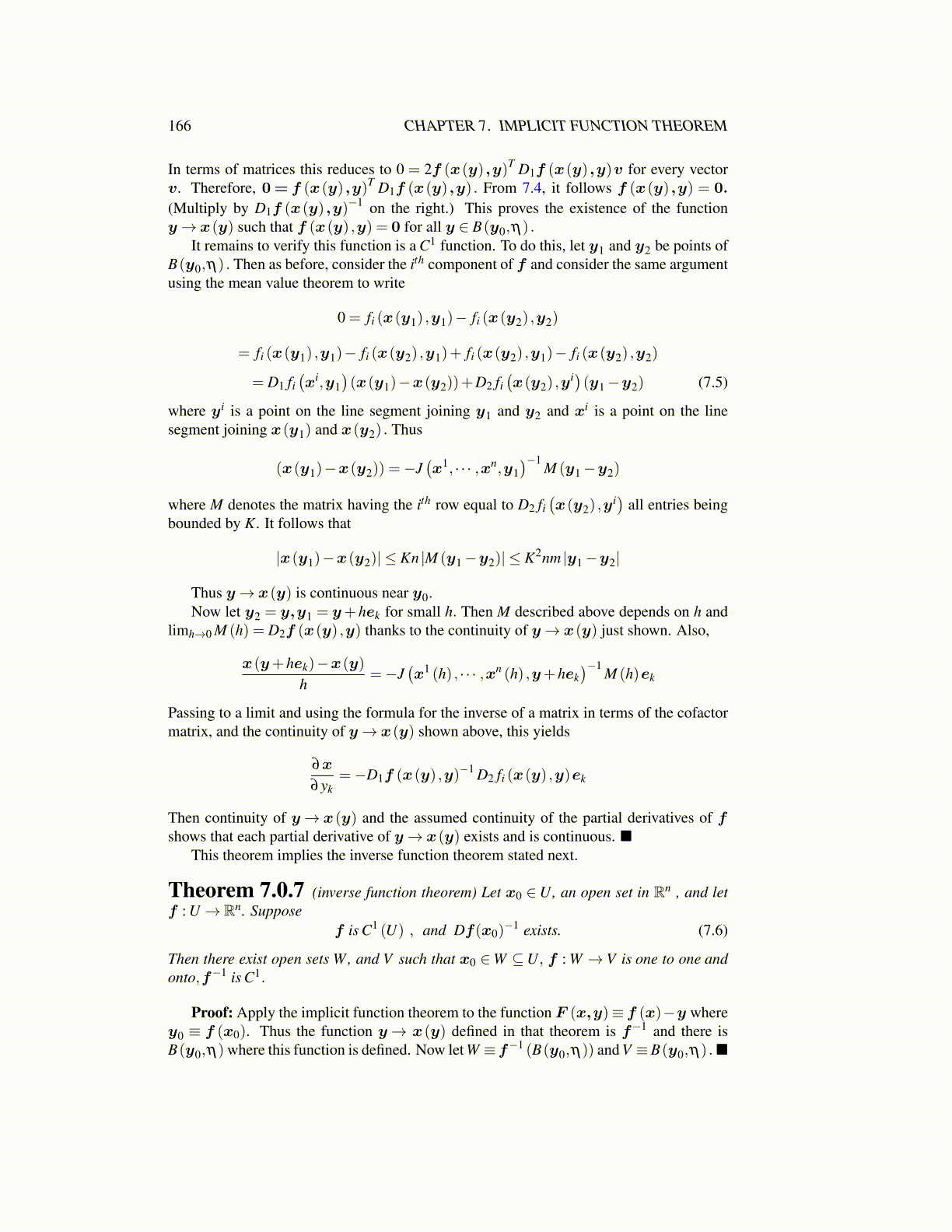
166 CHAPTER 7. IMPLICIT FUNCTION THEOREM
In terms of matrices this reduces to 0 = 2f (x(y) ,y)T D1f (x(y) ,y)v for every vectorv. Therefore, 0 = f (x(y) ,y)T D1f (x(y) ,y) . From 7.4, it follows f (x(y) ,y) = 0.
(Multiply by D1f (x(y) ,y)−1 on the right.) This proves the existence of the functiony→ x(y) such that f (x(y) ,y) = 0 for all y ∈ B(y0,η) .
It remains to verify this function is a C1 function. To do this, let y1 and y2 be points ofB(y0,η) . Then as before, consider the ith component of f and consider the same argumentusing the mean value theorem to write
0 = fi (x(y1) ,y1)− fi (x(y2) ,y2)
= fi (x(y1) ,y1)− fi (x(y2) ,y1)+ fi (x(y2) ,y1)− fi (x(y2) ,y2)
= D1 fi(xi,y1
)(x(y1)−x(y2))+D2 fi
(x(y2) ,y
i)(y1−y2) (7.5)
where yi is a point on the line segment joining y1 and y2 and xi is a point on the linesegment joining x(y1) and x(y2) . Thus
(x(y1)−x(y2)) =−J(x1, · · · ,xn,y1
)−1M (y1−y2)
where M denotes the matrix having the ith row equal to D2 fi(x(y2) ,y
i)
all entries beingbounded by K. It follows that
|x(y1)−x(y2)| ≤ Kn |M (y1−y2)| ≤ K2nm |y1−y2|
Thus y→ x(y) is continuous near y0.Now let y2 = y,y1 = y+hek for small h. Then M described above depends on h and
limh→0 M (h) = D2f (x(y) ,y) thanks to the continuity of y→ x(y) just shown. Also,
x(y+hek)−x(y)
h=−J
(x1 (h) , · · · ,xn (h) ,y+hek
)−1M (h)ek
Passing to a limit and using the formula for the inverse of a matrix in terms of the cofactormatrix, and the continuity of y→ x(y) shown above, this yields
∂x
∂yk=−D1f (x(y) ,y)−1 D2 fi (x(y) ,y)ek
Then continuity of y→ x(y) and the assumed continuity of the partial derivatives of fshows that each partial derivative of y→ x(y) exists and is continuous. ■
This theorem implies the inverse function theorem stated next.
Theorem 7.0.7 (inverse function theorem) Let x0 ∈U, an open set in Rn , and letf : U → Rn. Suppose
f is C1 (U) , and Df(x0)−1 exists. (7.6)
Then there exist open sets W, and V such that x0 ∈W ⊆U, f : W → V is one to one andonto,f−1 is C1.
Proof: Apply the implicit function theorem to the function F (x,y)≡ f (x)−y wherey0 ≡ f (x0). Thus the function y→ x(y) defined in that theorem is f−1 and there isB(y0,η) where this function is defined. Now let W ≡ f−1 (B(y0,η)) and V ≡B(y0,η) .■